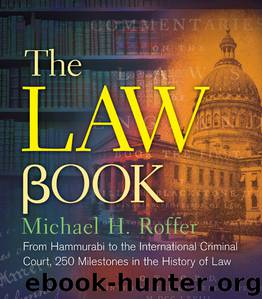The Law Book: From Hammurabi to the International Criminal Court, 250 Milestones in the History of Law by Michael H. Roffer

Author:Michael H. Roffer
Language: eng
Format: epub
Ring Lardner Jr. (left) and Lester Cole (right), two of the Hollywood Ten, arriving at court in 1950.
1948
Universal Declaration of Human Rights
Eleanor Roosevelt (1884–1962)
The United Nations’ 1948 Universal Declaration of Human Rights was born into a world emerging from the atrocities and horrors of global war. It represented the commitment of participating states to address and thereafter prevent such depravations.
Conceptually the declaration originated at the U.N. General Assembly’s first session in 1946 as a draft titled Declaration on Fundamental Human Rights and Freedoms. That document was referred to the eighteen-member Commission on Human Rights, chaired by Eleanor Roosevelt. At its first meeting in 1947, the commission undertook a preliminary draft of an International Bill of Human Rights. Roosevelt later described the completed declaration as “humanity’s Magna Carta.” The commission’s final draft was circulated among all U.N. member governments in 1948, and it underwent rounds of revisions. Hernán Santa Cruz, Chilean ambassador to the U.N., called it “a truly significant historic event in which a consensus had been reached as to the supreme value of the human person.… In the Great Hall … there was an atmosphere of genuine solidarity and brotherhood among men and women from all latitudes.”
The General Assembly’s final deliberations began in September 1948, and the declaration was adopted unanimously (with eight abstentions) in December 1948. Political scientist George J. Andreopoulos highlights its core tenets as “a commitment to the inherent dignity of every human being and a commitment to nondiscrimination,” and identifies some of its key civil and political rights—freedom from torture, to have an effective remedy for human rights violations, and to take part in government—as well as key economic, social, and cultural rights—a right to work, to form and to join trade unions, and to participate in “the cultural life of the community.”
The nonbinding nature of the declaration has led to criticism concerning its effectiveness, but as Andreopoulos notes, most commentators view it as having achieved the authority of customary international law. He concludes: “More than any other instrument, the UDHR is responsible for making the notion of human rights nearly universally accepted.”
SEE ALSO The Declaration of the Rights of Man (1789); The Bill of Rights (1791); The European Court of Human Rights (1959).
Download
This site does not store any files on its server. We only index and link to content provided by other sites. Please contact the content providers to delete copyright contents if any and email us, we'll remove relevant links or contents immediately.
The Secret History by Donna Tartt(18852)
The Social Justice Warrior Handbook by Lisa De Pasquale(12143)
Thirteen Reasons Why by Jay Asher(8800)
This Is How You Lose Her by Junot Diaz(6796)
Weapons of Math Destruction by Cathy O'Neil(6148)
Zero to One by Peter Thiel(5690)
Beartown by Fredrik Backman(5600)
The Myth of the Strong Leader by Archie Brown(5427)
The Fire Next Time by James Baldwin(5250)
How Democracies Die by Steven Levitsky & Daniel Ziblatt(5129)
Promise Me, Dad by Joe Biden(5088)
Stone's Rules by Roger Stone(5027)
A Higher Loyalty: Truth, Lies, and Leadership by James Comey(4846)
100 Deadly Skills by Clint Emerson(4843)
Rise and Kill First by Ronen Bergman(4705)
Secrecy World by Jake Bernstein(4651)
The David Icke Guide to the Global Conspiracy (and how to end it) by David Icke(4628)
The Farm by Tom Rob Smith(4439)
The Doomsday Machine by Daniel Ellsberg(4419)
